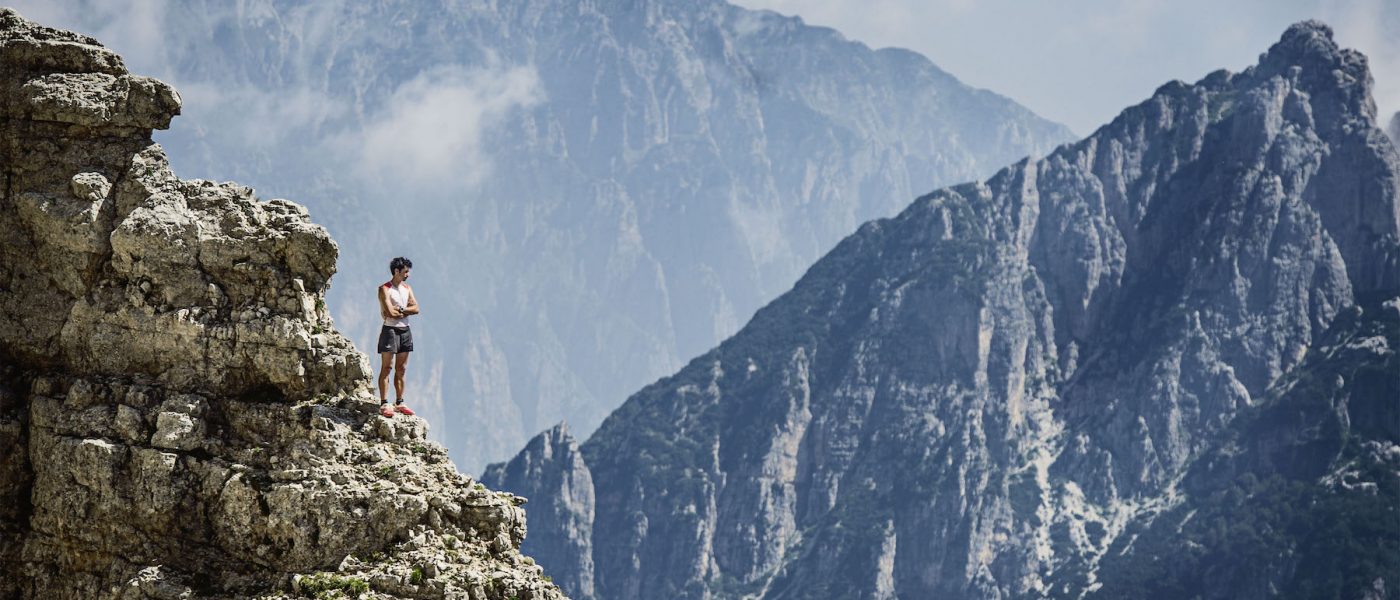On suffering, doping and victory: a Q&A with one of today’s most famous runners
Kilian Jornet hardly needs an introduction. The ski mountaineer and mountain runner has won races across the world, set countless speed records on routes. But after he added a double speed ascent of Everest in a single week earlier this year, his name was pushed even further into the spotlight as one the most famous athletes in the sport of ultrarunning.
We caught up with him to chat about his mental and physical training, upcoming goals and the evolution of ultrarunning as a sport.
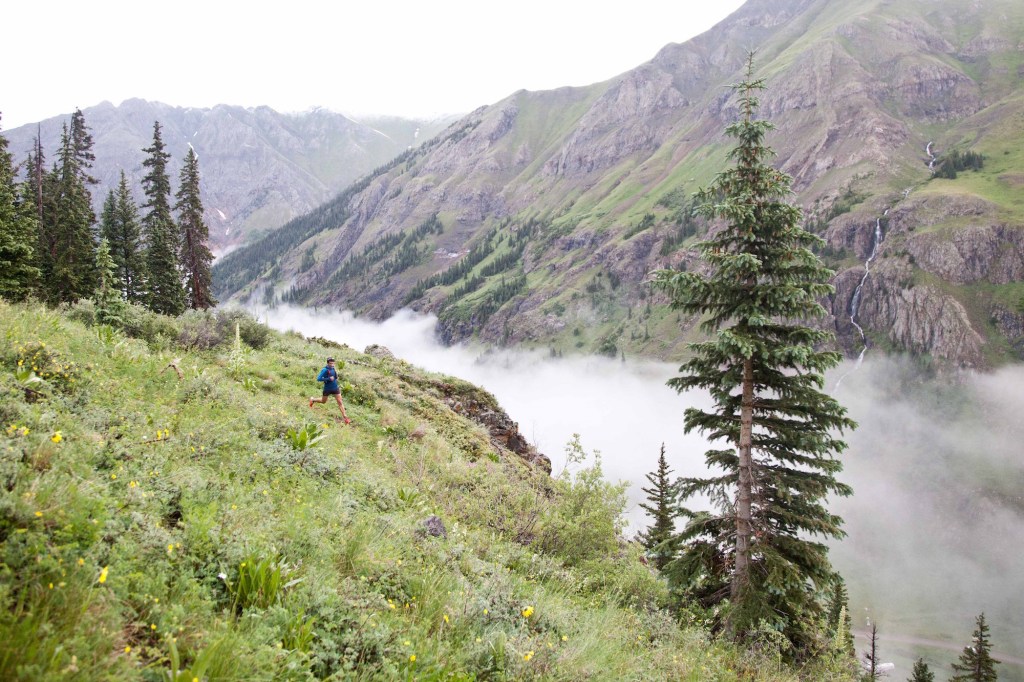
At the Hardrock 100 in 2015 | Photo: Rickey Gates
What does your training look like?
Since I was 17 years old, I’ve trained by myself. Before that, I had a coach who would tell me what I needed to do. I wanted to do much more, but she would say, “It’s good to do less before races.” I tried to do that. I’ve also studied sports science to get to know the basics. I like to experiment in training with extremes in order to know my body better. For instance, I might go without eating and keep training for four hours in the morning and then one hour in afternoon. Then, you see the power disappear. Then, after five days, I may reach the furthest point of ability and I’ll start eating again.
From November to May, I train with only skis: I train around two to four hours in the morning and one hour in the afternoon. In the summer, I switch to running and climbing in the mountains. In the morning, it’s usually two to three hours. If I spent less than five hours training in the morning, I do one hour in the afternoon. It can reach up to nine or ten hours for long days out. That comes out to around 1,200 hours a year and 600,000-700,000 meters [373-435 miles] a year.
[ed. note: REI does not suggest fasting for an extended period of time. Read this for tips on honing and maintaining a positive body image.]
How did you prepare yourself mentally for the Everest speed ascent?
I think it’s important to become confident through experience and knowledge in the mountains. In the last two years, I’ve been trying to put myself into situations in the mountains where I was previously afraid or not confident. For instance, going out for 20 or 30 hours or more alone, and going out in conditions that are not perfect and pushing my limit, trying to get used to it.
I think it’s important to take away emotion. If you have euphoria and are happy, you will make bad decisions because you will not see risk. If you panic and are scared, then you will stop or lose control of yourself. You have to take this away and just be rational and say, “OK, technically or physically does this decision make sense?” If the answer is no, then go home. If it’s yes, the decision is okay, and you need to ask yourself if you want to accept the risk or not. Feel that you may have tension, but you are comfortable and capable.

Photo: Markus Berger
What was your approach to hydration on Everest?
It’s always a compromise because you don’t want to carry much weight. I was carrying everything I needed. I took 2 liters and one froze. And going up I was able to drink, but going down I was sick. The first time I ascended, for the last 15 hours, I didn’t drink or eat anything because I was throwing up. I thought if I stopped eating and drinking, I would just deal with the pain and not throw up. The second time, I just had four flasks and two of them froze.
Do you have an interest in climbing Everest again?
I don’t know about Everest, but I will return to the Himalayas. It was interesting to climb there. I didn’t know how 8,000 meters would be for me—it was a big question. Now, I know it’s possible for me to climb up there without oxygen and, in one month, to go four times over 8,000 meters. It is possible to do a lot of activity there and to not spend two months at the basecamp to acclimate.
When you were are at Everest Base Camp and received news of Ueli Steck’s accident, how did it affect you?
It was hard. We were going down with Emelie [Forsberg], my girlfriend, and when we arrived at the basecamp we saw the message. We had been in contact with Ueli, sharing pictures and things.
Ueli and I had climbed together, and he was a big mentor of mine. I learned so much climbing with him. He was pushing alpinism in a way and that was inspiring. But, when someone who’s doing that dies, you have doubts about whether or not what you are doing is OK: Is it correct? Is it worth the risk to do that? Last year, I took much more risk and accepted much more risk. How much risk you accept goes up and down a bit over time. When an accident has happened, you want to stay as safe as possible and not accept as much risk.
Have you noticed more alpinists blending running with climbing, and vice versa?
Ueli Steck trained by running and competing in 100K and 50K races. It was his main form of training. It increased his shape and performance in the mountains. Many alpinists are starting to train more and run more. It increases your fitness, so you can do more objectives in big mountains. Alpinists are technically skilled already but physically, maybe not so much. The faster they are, the more possible it is to do climbs.
More runners are going to the mountains, too. I think the more you are in the mountains, the more you understand problems you may face while climbing. If you come to Chamonix and go climbing, you will see how strange the crevasses are, so being more out there means having more knowledge, and then you will be more aware of that obstacle.
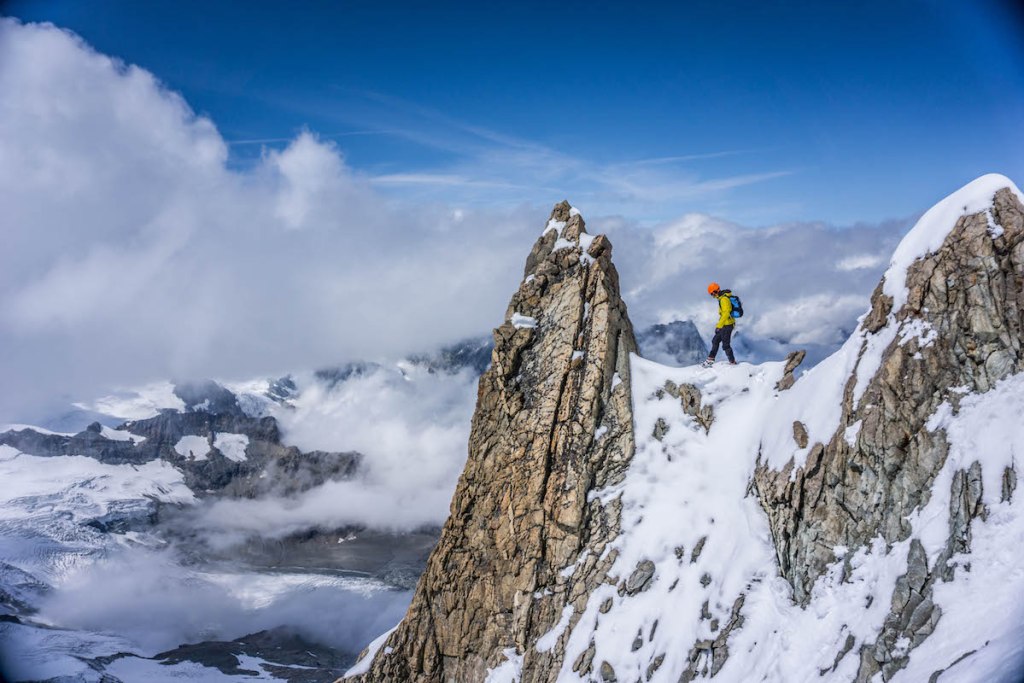
Dente Blanche 2015 | Photo provided by Salmon/rygr PR
Do you think there is a doping problem in trail running?
I don’t think there are many people doping in trail running but there could be a few cases. It’s sad to think about someone doping to reach their goal—they must be unhappy on some level. Someone who is doping in a sport like this is not doing it to get money. It’s important for the next generation to show that it’s under control and that it is not normal. Anti-doping tests should become more common.
Here in Europe, compared to the U.S., we have a lot of controls through drug testing within skiing and running races. I came into running from ski mountaineering and for the last 10 years, I’ve been tested [through the WADA-sanctioned testing] close to every day at home or where I am traveling. To prevent doping, it’s important to create obstacles and build transparency.
[Ed. note: Jornet is also tested randomly for the Athlete Transparency Program, launched by Salomon in 2017.]
How many times during ski season are you tested?
With WADA, people don’t know how many times they’ll be tested and it changes each year. This year, I have only been tested three times, but sometimes it’s fifteen times. I’m tested often.
As mountain running has come to age in the last 10 years, has testing changed the sport?
No, I don’t think testing has changed the sport. The sport has been clean and it will continue to be. The only thing is you have to pee after the race or at home, and it’s not inconvenient for the athlete’s life. When I travel, I just have to remember to report where I am.
In what ways has the sport of ultrarunning changed?
I think that my generation was the first ones to have young—under 20 years old—athletes running long distances. Now, athletes are coming from college, like Sage Canaday or Zach Miller, who have a background in athletics. There’s more going on strategically, and those types of runners go fast from the beginning. This new approach presents a challenge and a need for all of the other runners to train more on flats in order to run fast. It’s an interesting, good change for the sport.
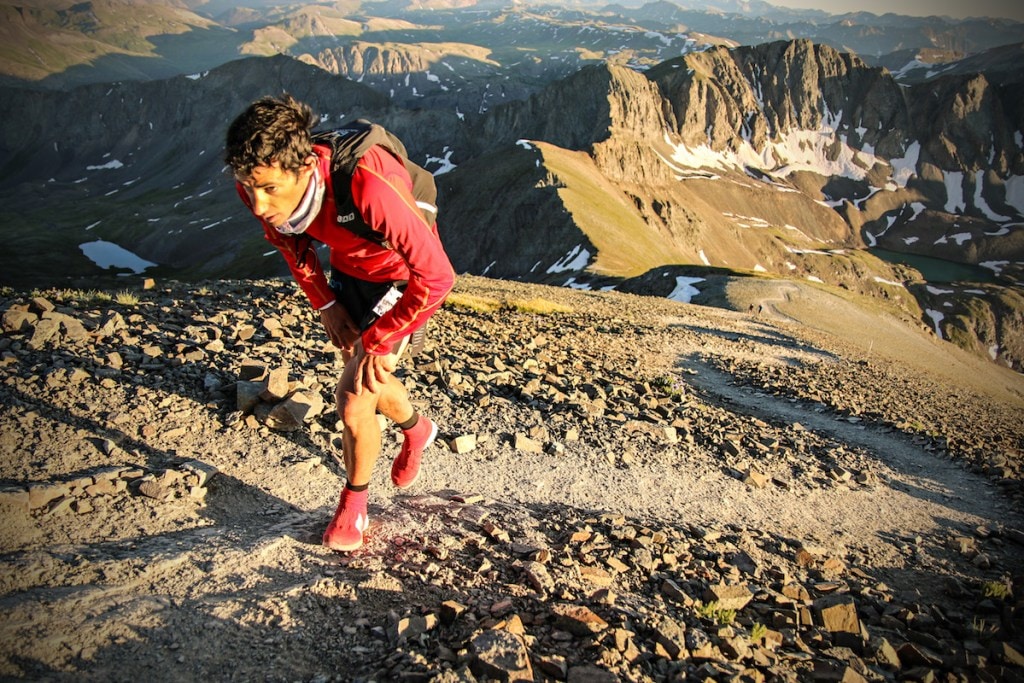
Hardrock 100 | Photo: Philipp Reiter
How have your accumulative experiences, and moments of pain or suffering, allowed you to build a tolerance to reach your goals?
Suffering is never an objective, but there are a lot of ways to suffer mentally or physically. It has evolved for me. I think you begin to feel more confident in situations after you’ve experienced them more than once, even if you felt suffering or were afraid the first time, as long as you are safe. If I suffer one time from the cold, but I don’t get frostbite or die, then I know that it’s not dangerous. Then the next time I am in a situation where I am uncomfortable but I am safe and okay, I won’t suffer in the same way as I did the time before.
On Everest, I was suffering due to my stomach but it felt the same as if I were at home and had cramps. The only difference was that I was up there. I knew that I was well-acclimatized. I wasn’t cold, so I knew that I would not lose my feet or have hypothermia. I knew I would need to go slower and stop more frequently. But, I knew I would not die.
Is there an easy way to remove that emotion or are you conditioned to it now?
You spend hours and hours in these situations. It’s mediation in a way, but I think you feel more confident if you have more knowledge about the conditions. Then when you finish, you feel the emotions: You feel relieved and think, “I am well and I am alive.” Then, “I am happy with what I’ve done.”
How has your perspective on racing and running changed since you were young?
I am still competitive. If I start a race and have the capacity to win, then I want to win. But before, I was more focused on that, so my training revolved more around the races. The day before a race, I wouldn’t train, so that I would be able to win it. Now, if the conditions are super in the mountains the day before the race, I say, “I want to go climbing!” I’m less focused on that training aspect, and I like to enjoy a greater variety of things.
Before I was training more specifically for ski mountaineering races and trail running races. Now with more experience, I can do more things and maintain how in shape I am. My perspective now is that races are like training. They’re more to keep me in shape and able to do more things in the mountains. It’s also fun to race. I don’t put the first priority on races; I put the priority of everything—training, races, mountain goals—on the same level.
A nice thing about racing is that it always puts you in a place to see how your training compares to others. This will make you train harder and it’s a kind of motivation. I also just like racing for racing: It’s fun, it’s a game, and just like when you’re a kid, you want to beat the other kids.
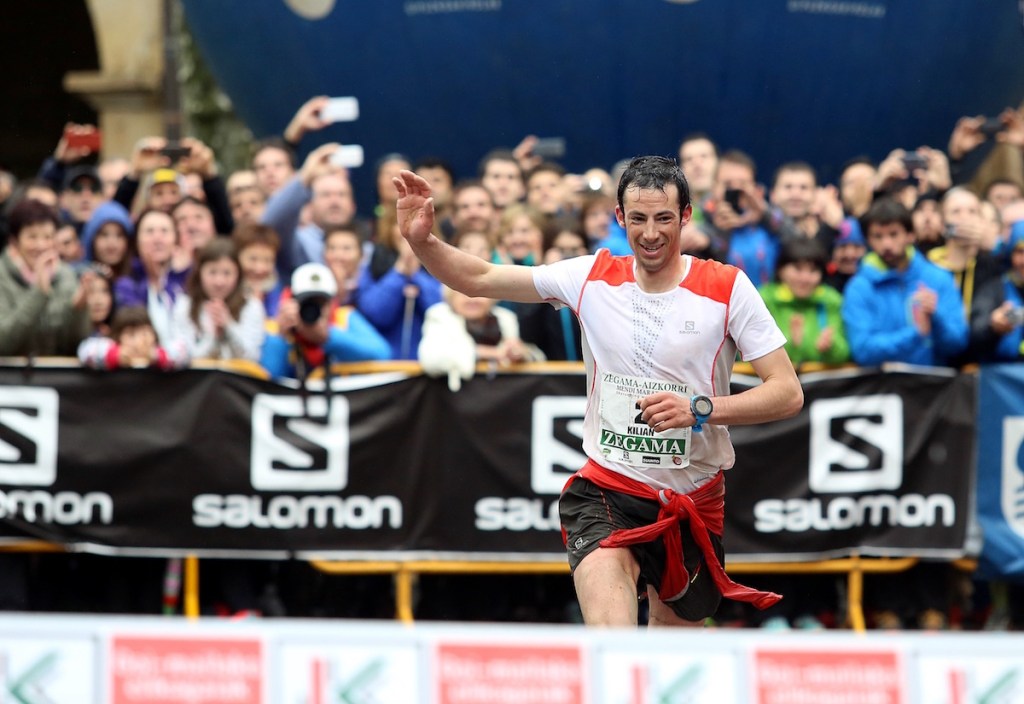
Zegama, Spain, 2017 | Photo: Javi Colmenero
What’s next for you?
I have a lot of ideas in the back of my mind of what I want to do next. The list is huge and keeps evolving, and this is the problem! The more I see and the more I do things, the bigger and more things I want to do. You have to choose which goals come first. I don’t like to specialize in anything. I am happy doing a big mountain or expedition in Himalaya and doing a technical climb or fast ascent, and then two weeks afterward, doing a short race, and then one week after an ultra race, and then in the winter, I am happy skiing. I like to do different things because then you know yourself in different ways and put yourself in different situations and have different emotions.
I would really like to go to Pakistan because I have never been there and people say the mountains are beautiful. I want to go to Alaska, again, because the mountains are incredible. Greenland also seems to have a big potential!
